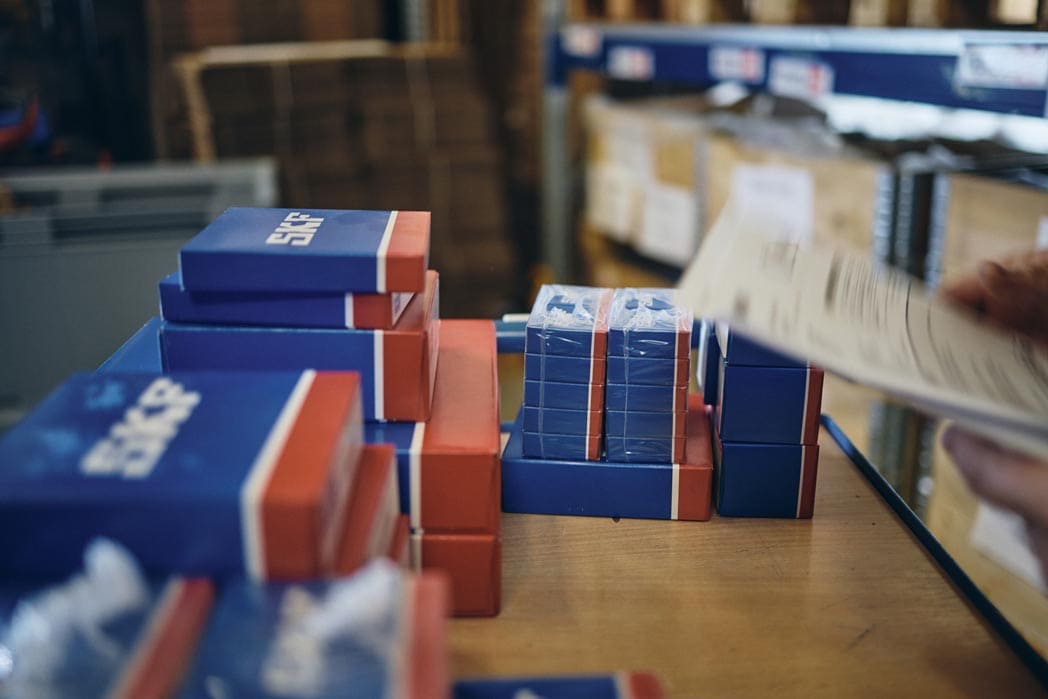In this encyclopaedia you will find detailed information about different types of rolling bearings, their design, function and areas of application.
Rolling bearings are bearings that consist of an inner and an outer ring. Balls or rollers are inserted between these rings, which can move in relation to each other. This reduces rolling resistance, transfers a rotational movement via the rolling element and transmits forces. Rolling bearings are used to hold shafts or axles in place. A distinction is made between ball bearings and roller bearings on the basis of the rolling element.
The six basic forms include
Ball bearings
Cylindrical roller bearings
Needle roller bearings
Tapered roller bearings
Spherical roller bearings
Toroidal roller bearings (SKF, FAG)
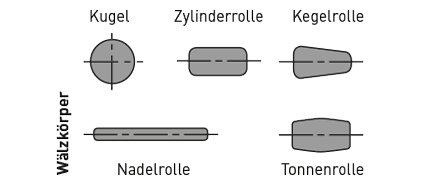
The lubrication, oil or grease, reduces the friction and wear of the bearings. A film is formed which prevents direct contact between the bearing rings, rolling elements and cage. This film of grease also prevents the penetration of foreign bodies and protects against rust and corrosion. In addition, heat is conducted away from the bearing during oil lubrication. However, bearings and oil should be cooled at high temperatures.
Conclusion: The service life of the bearings increases depending on the viscosity and thickness of the lubricating film.
The following factors must be considered when selecting the lubrication method:
- Prevailing operating conditions
- Requirements for the rolling bearing:
- Running, noise, temperature and friction behaviour
- Protection against corrosion, penetrating particles (liquids, sand), fatigue, wear
- Effort and costs for lubrication
Important: Permanent lubricant supply and lubricant adhesion at all contact points must be guaranteed:
- Permanent oil supply (e.g. through automatic lubrication systems from Betex)
- Defined relubrication intervals
High temperatures:
High mileage and speeds expose bearings to high temperatures. Here we recommend High temperature grease. Depending on the operating temperature, a distinction is made between
- Lithium soap grease (max. 70 °C)
- High-temperature grease with mineral oil content, incl. temperature-stable thickener (80 – 110°C)
- High-temperature grease with synthetic base oil (up to 250°C)
Niedrige Temperaturen:
Bei niedrigen Temperaturen herrscht eine höhere Startreibung. We recommend low-temperature greases here. Compared to multi-purpose grease, a lower starting friction is generated here.
- Low temperature greases: Low viscosity base oil in combination with lithium soap
Condensation:
If there is space between the bearing and the housing, moisture can accumulate there. The result is corrosion. We therefore recommend greases with sodium bicarbonate or lithium as a base.
- Sodium soap fat: emulsifies with water, but can leak out if it becomes too soft
- Lithium soap fats: does not emulsify with water. Effective rust protection.
Splash water:
In the case of splash water, a water-repellent grease should be used, e.g. calcium soap grease, which also protects against rust.
Special greases must be used for otherexternal influences such as acids, alkalis, etc. Für andere äußere Einflüsse wie Säuren, Laugen usw. müssen spezielle Fette verwendet werden.
Depending on the operating conditions, mineral oils and synthetic oils are used. Synthetic oils are used under extreme operating conditions. As mineral oils form a so-called oil carbon at temperatures above 150°C, residues can settle in the bearing at high temperatures. This leads to wear.
- Grease the bearing so that all contact surfaces contain grease
- Fill the housing compartment with grease to the extent that the displaced grease from the bearing can still be accommodated -> Filling to 30% is recommended
- If a very large housing space is available, we recommend additionally fitting the bearings with cover or sealing discs
- Grease fast rotating bearings only 20-30% so that grease distribution is accelerated when the bearing starts up and the grease is better distributed
- Fully grease slowly rotating bearings
- Bearings with rotating outer ring can only hold 15% grease filling
Greases
Relubrication is required if the grease operating life is less than the bearing life. For frequent relubrication, we recommend grease pumps or volumetric metering distributors. The aim is to displace the old grease with the new grease. This usually requires several relubrications.
Oils
If the oil cannot be exchanged via splash lubrication, oil is added by pumps, oil mist systems, oil-air systems or oil centralised lubrication systems, depending on the application.
Monitoring the bearings
Condition Monitoring: Vibration, wear and temperature measurement
Monitoring the lubrication
- Analysis: Monitoring through lubricant removal
- Measurement of oil pressure, oil level, oil flow rate, oil temperature
Due to the advantages of low starting frictional torque, low lubricant consumption and long service life, rolling bearings can be used in a wide range of applications. They are therefore used wherever high loads need to be moved with low friction at low speeds and the speeds change frequently.
The air between the rings and rolling elements is referred to as the internal clearance. As the internal clearance has an influence on the running smoothness, service life and operating temperature of the bearing, the internal clearance must be calculated precisely. A distinction is made between radial and axial internal clearance.
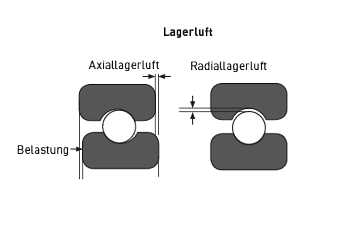
The radial internal clearance is determined on the basis of a measured load acting on the bearings. The elastic displacement always results in a larger value of the measured clearance compared to the actual internal clearance. Correcting the measured internal clearance by the elastic displacement results in the actual radial internal clearance. In the case of roller bearings, the elastic displacement is not relevant when calculating the internal clearance.
The axial clearance is measured when the bearings are not installed. The dimension is measured in which the bearing rings can be moved against each other in the axial direction. The bearings are rotated and moved from one end position to the other until they are tension-free. The distance between the two end faces added together gives the intermediate ring width. The aim is to achieve zero axial clearance so that the external forces are distributed to all rolling elements.
Rolling bearings can be arranged in fixed-lot bearing arrangements or in carrier/support bearing arrangements.
Fixed-lot storage
One of the bearings is fixed and cannot be moved in an axial direction. It must absorb axial and radial forces as well as transfer them to the surrounding structure. The non-locating bearing, on the other hand, is movable and can move in an axial direction. It does not absorb axial forces and can compensate for tolerances and thermal expansion.
Carrier-support bearing
The support force is distributed to both bearings in such a way that both bearings together can absorb all axial forces. Axial play is required.
Possible and very common locating/non-locating bearing combinations for rigid bearing arrangements in which the axial displacements should be practically frictionless in the bearing are:
Deep groove ball bearings with cylindrical roller bearings
Double row angular contact ball bearings with cylindrical roller bearings
Matched single row tapered roller bearings with cylindrical roller bearings
Cylindrical roller bearings of the NUP design with one of the NU design
Cylindrical roller bearings of the NU design and four-point bearings with cylindrical roller bearings
For slip-free operation, particularly at high speeds and accelerations, a minimum radial load must be applied to the bearings, otherwise the rolling elements will slide on the raceway, which can lead to surface damage.
A rolling element consists of the outer ring, inner ring and rolling element assemblies. There must be clearance between the rolling elements and the bearing rings so that they can move when at operating temperature.
Maintenance-free rolling bearings are bearings that are sealed on both sides, are permanently lubricated and must not be washed or relubricated during their service life.
Before installation, the bearings must be stored in their original packaging as they are very sensitive to dirt and corrosion. The joining force must not be transmitted via the rolling elements during assembly. The bearings should be mounted using mechanical or hydraulic presses. Bearing inner rings that have to support circumferential loads should be heated before mounting. More information.
Advantages
- Lower friction losses and less heat generation
- High load capacity at low speeds
- Low lubricant consumption
- Interchangeability due to standardised sizes: Components, installation conditions,
- Maintenance-free with sufficient lubrication
Disadvantages
- Higher noise level due to the rolling elements
- Larger construction volume
- Sensitive to shock loads
- Lower guidance accuracy
- Speed limiter
The basic designations of rolling bearings are defined in accordance with DIN 623 or ISO.
Bearing shape and bore diameter are broken down in this way: 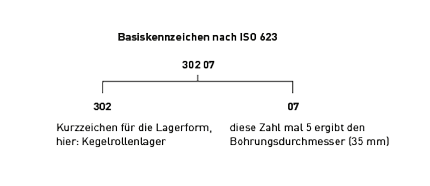
Case hardening is the hardening of the surface of a steel workpiece by carburising, hardening and tempering, whereby the core remains soft and tough. In this process, the surface layer is first enriched with carbon at temperatures between 880 and 950 °C (max. temperature 1050 °C). The workpiece is then “quenched”. Typical procedures are:
Quenching in liquid quenching media
- Water
- Hardening oil
- Polymer
- Molten salt
- Molten metal
And quenching in gaseous quenching media
- Nitrogen
- Helium
- Gas nozzle field
The surface hardness and case hardening depth depend on the carbon accumulation in the surface layer.
In the next step, the workpiece is tempered. In this heat treatment process, the piece is heated in a targeted manner to relieve internal stresses. The higher the steel is tempered, the softer it becomes. The hardness decreases and the toughness increases.
The goal is:
- The increase in wear resistance due to increased surface layer hardness
- Increasing the load capacity
- The increase in fatigue strength
- Improved flexural fatigue strength and overload tolerance thanks to tough core
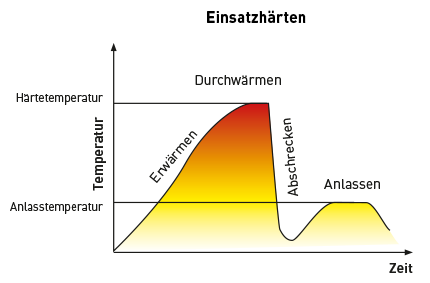
Lubrication of the ball bearing alone can prevent the ingress of dirt and dust. However, seals can also insulate the penetration of dust, water, vapour, etc. Labyrinth seals, pointed rings, radial shaft seals and resilient cover discs are often used. Felt rings are also suitable, but rub and damage when hard.
1. first determine the bearing type:
Ball bearing – single row, double row, contact angle
2. If the abbreviation of the bearing (located on the inner ring, outer ring or outer diameter) is illegible, the following must be determined:
- Inner ring bore (inner diameter)
- Outer diameter of the outer ring
- Inner and outer width (can be different)
- Bore shape and/or outer diameter of the bearing
3. Search the manufacturer’s catalogue or contact customer service directly.
Hybrid ball bearings are rolling bearings that are made from two materials. These include steel races combined with ceramic rolling elements. The most common type of hybrid ball bearing is the deep groove ball bearing.
- What are deep groove ball bearings?
- What are radial ball bearings?
- What are radial ball bearings?
- What are axial deep groove ball bearings?
- What are angular contact ball bearings?
- What are axial angular contact ball bearings?
- What are double row angular contact ball bearings?
- What are self-aligning ball bearings?
- What are spindle bearings?
- What are linear ball bearings?
- What is a freewheel ball bearing?
- What are thrust ball bearings?
- What are low-friction ball bearings?
- What are flanged ball bearings?
- What are flange ball bearings?
- Why ball bearings with seals?
- What are waterproof ball bearings?
- What are ball bearings?
- What are ceramic ball bearings?
- Why stainless steel ball bearings?
- What are ball bearings with mountings?
- What are ball bearings with shafts?
- What are ball bearings for turntables?
- What are shoulder ball bearings?
- What are plain bearings?
- What are plain bearings for shafts?
- What are flanged plain bearings?
- What are Teflon plain bearings?
- What are steel plain bearings?
- What are sintered bronze plain bearings?
- What are self-lubricating plain bearings?
- What are bronze plain bearings?
- What are linear plain bearings?
- Why lubrication for plain bearings?
- What are housing bearings?
- What are flange bearings?
- What are special roller bearings?
- What is a castor wheel?
- What are castors with ball bearings?
- What are stainless steel castors?
- What are plastic castors?
- What are plastic castors with ball bearings?
- What are support rollers?
- What are cam rollers?
- What are spring-loaded castors?
- What are cone rollers?
- What are steel castors?
- What are castors with axles?
- What are nuts?
- What is a slotted nut?
- What is a DIN 981 slotted nut?
- What is a DIN 1804 slotted nut?
- What are self-locking slot nuts?
- What is a slotted nut with a retaining plate?
- What are T-slot nuts?
- What is a hollow pin?
- What is a wave nut?
- What is a wave nut with a locking plate?
- What is a DIN 1481 clamping sleeve?
- What are clamping sleeves?
